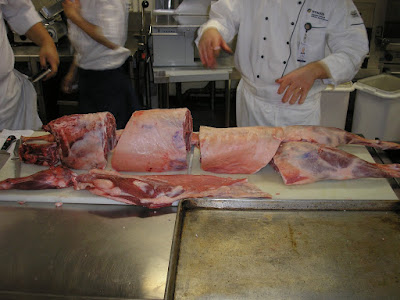
Observe, one lamb carcass. This was part of the CWC advanced charcuterie program I went through. The highlight of this particular day was not when we ended up making awesome merguez sausage out of the lamb, but when an obviously distraught vegetarian peeped through the door to the kitchen and loudly deemed all of us chefs to be "murderers!". ...it was pointed out she was wearing leather. (Check & Mate!)
Now with the door to the kitchen closed...
There are five primal portions of lamb to note. First, shown here is the "Shank" and "Breast". Shanks are great to braise (especially served with Risotto) and breast meat is usually best used minced (think Shepherd's Pie).
Cut one inch above the ending joint of the arm bone across and into the 12 ribs, perpendicular to where the 13th rib ends (This is way easier than I make it out to sound).
Done. Easy. Moving on.
Next up, the shoulder (Shown here to the far left). There are two decent applications that you can do with lamb shoulder. First, because of it's amount of connective tissue, it's ideal for cubed pieces to stew. Second, it's possible to de-bone, stuff it, and make a roll out of it. Though I prefer the stewed version more because I am a big sucker for curried lamb (...with some fragrant jasmine rice ...amazing).

Using a big saw because a pairing knife would take to long, cut through the blade bone between the 4th and 5th rib.

Done. Admire your butchery skills momentarily.

Next up, the famous "Rack". Because this cut houses the rib eye muscle, it's regarded as the most tender, sought after cut (though, not the most flavourful) of lamb. Don't screw up.


The Loin is also useful in dry-heat cooking, great for producing medallions, the loin houses the tenderloin and is quite tender.

The legs are handled in a few fashions. Bone-in legs are used for buffet services, the sirloin portion being much more suitable for dry-heat cooking than the bottom shank (braised). Do I really need to explain how to cut them bilaterally?

Using a big saw because a pairing knife would take to long, cut through the blade bone between the 4th and 5th rib.

Done. Admire your butchery skills momentarily.

Next up, the famous "Rack". Because this cut houses the rib eye muscle, it's regarded as the most tender, sought after cut (though, not the most flavourful) of lamb. Don't screw up.
Make two cuts between the 5th and 12th rib.
Afterwards, you can go on to split the rack into two, and proceed to french the ribs to make a proper "Frenched Lamb Rack" .

The Hindsaddle (minus Kidneys).
At the forefront, the "Loin", followed by the "Legs".

The Loin is also useful in dry-heat cooking, great for producing medallions, the loin houses the tenderloin and is quite tender.
The incision should be made (assuming you have already removed the Rack) on the very last chine bone right before the beginning of the pelvic bone.

The legs are handled in a few fashions. Bone-in legs are used for buffet services, the sirloin portion being much more suitable for dry-heat cooking than the bottom shank (braised). Do I really need to explain how to cut them bilaterally?




No comments:
Post a Comment